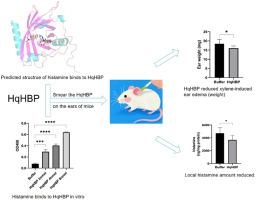HqHBP, a histamine-binding protein derived from the hard tick Haemaphysalis qinghaiensis, alleviates xylene-induced mice skin edema
IF 2.4
3区 农林科学
Q1 FISHERIES
引用次数: 0
Abstract
As one of the most important blood-sucking parasites, ticks can secrete various biological molecules to counteract responses such as hemostasis and inflammation in their host during the blood-feeding process. A cDNA clone named as Hq018 was identified from a salivary gland cDNA expression library of Haemaphysalis qinghaiensis. A protein consisting of 217 amino acids with a molecular mass of 24.4 kDa was encoded by the tick cDNA. Homology analysis using database comparisons revealed that Hq018 protein is a homology of a histamine-binding protein identified in a female Rhipicephalus appendiculatus. Recombinantly produced protein by Hq018 cDNA in Escherichia coli could dose-dependently bind to histamine in an enzyme-linked immunosorbent assay (ELISA)-based histamine-binding test. We designated this H. qinghaiensis orignated histamine-binding protein as HqHBP. HqHBP could significantly inhibit xylene-induced mice ear edema and the accompanied vascular dilation, mucus secretion and increase of mast cells, reduce the amount of histamine and the expression levels of some inflammatory factors in mice skin. These results suggest that HqHBP exhibits potent antihistamine activity. HqHBP might be a good candidate for the development of pharmaceutical products aimed at preventing and treating anaphylactic reactions.

HqHBP是一种从海南血蜱中提取的组胺结合蛋白,可减轻二甲苯诱导的小鼠皮肤水肿。
作为最重要的吸血寄生虫之一,蜱虫在吸血过程中可以分泌多种生物分子来对抗宿主的止血、炎症等反应。从海南血蜱唾液腺cDNA表达文库中鉴定出一个cDNA克隆,命名为Hq018。蜱虫cDNA编码了一个由217个氨基酸组成的蛋白,分子量为24.4 kDa。同源性分析显示,Hq018蛋白与雌性尾尾棘头虫组胺结合蛋白同源。Hq018 cDNA在大肠杆菌中重组产生的蛋白在基于酶联免疫吸附试验(ELISA)的组胺结合试验中能够剂量依赖性地与组胺结合。我们将这一青海血吸虫源的组胺结合蛋白命名为HqHBP。HqHBP能显著抑制二甲苯诱导的小鼠耳部水肿及其伴随的血管扩张、粘液分泌和肥大细胞增加,降低小鼠皮肤组胺量和部分炎症因子的表达水平。这些结果表明HqHBP具有有效的抗组胺活性。HqHBP可能是开发用于预防和治疗过敏反应的药品的良好候选者。
本文章由计算机程序翻译,如有差异,请以英文原文为准。
求助全文
约1分钟内获得全文
求助全文
来源期刊
CiteScore
6.20
自引率
6.90%
发文量
206
审稿时长
49 days
期刊介绍:
Developmental and Comparative Immunology (DCI) is an international journal that publishes articles describing original research in all areas of immunology, including comparative aspects of immunity and the evolution and development of the immune system. Manuscripts describing studies of immune systems in both vertebrates and invertebrates are welcome. All levels of immunological investigations are appropriate: organismal, cellular, biochemical and molecular genetics, extending to such fields as aging of the immune system, interaction between the immune and neuroendocrine system and intestinal immunity.

 求助内容:
求助内容: 应助结果提醒方式:
应助结果提醒方式:


